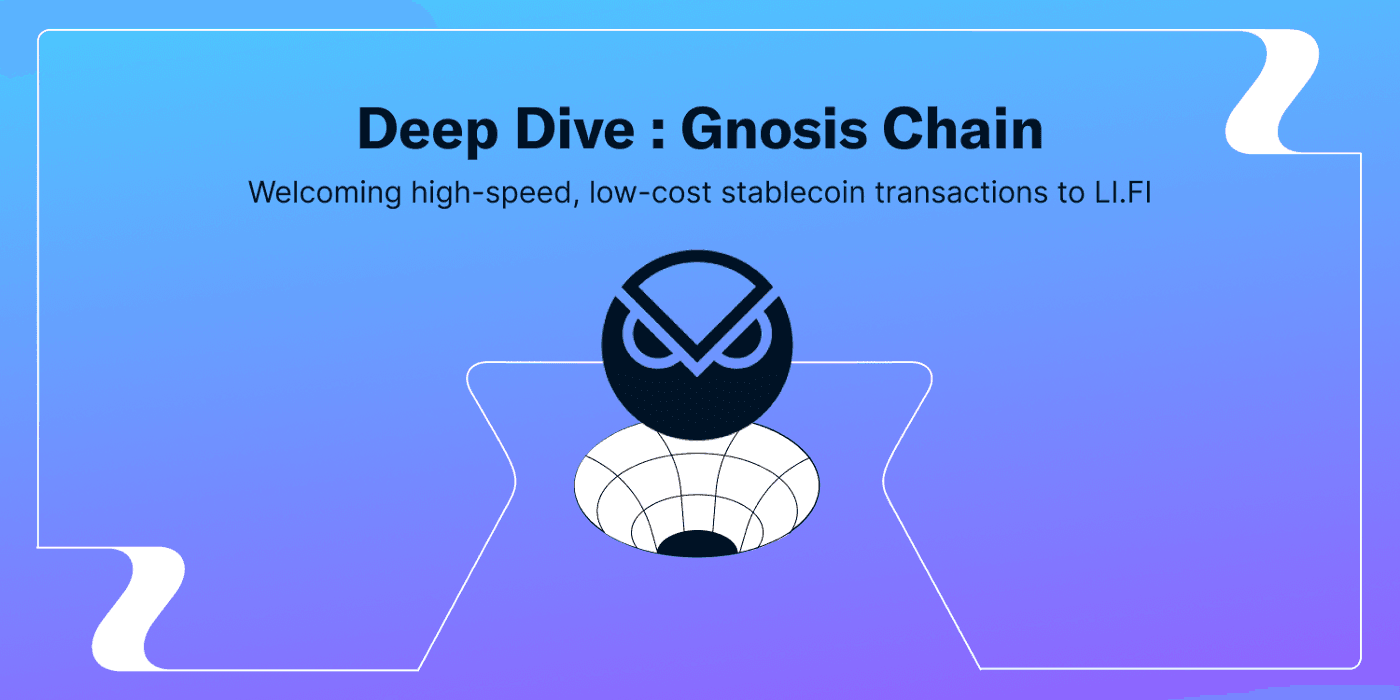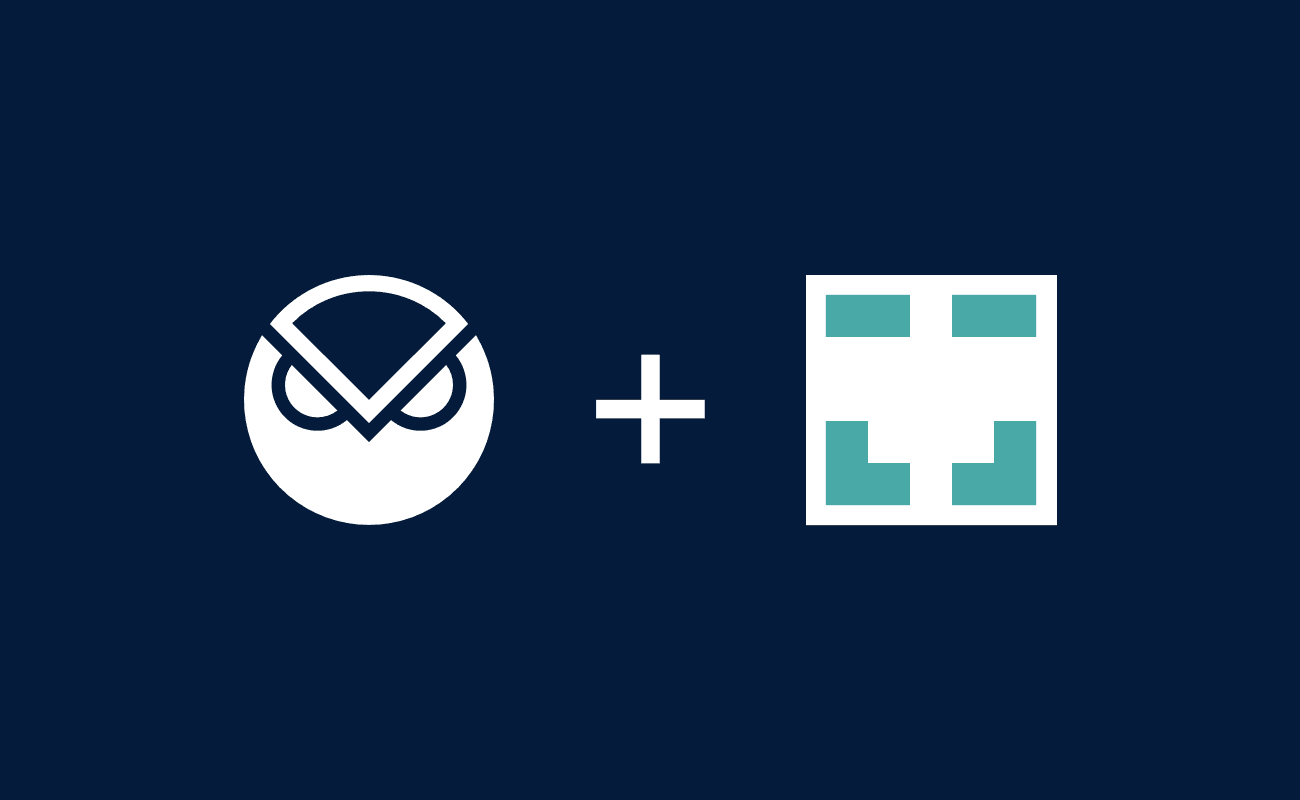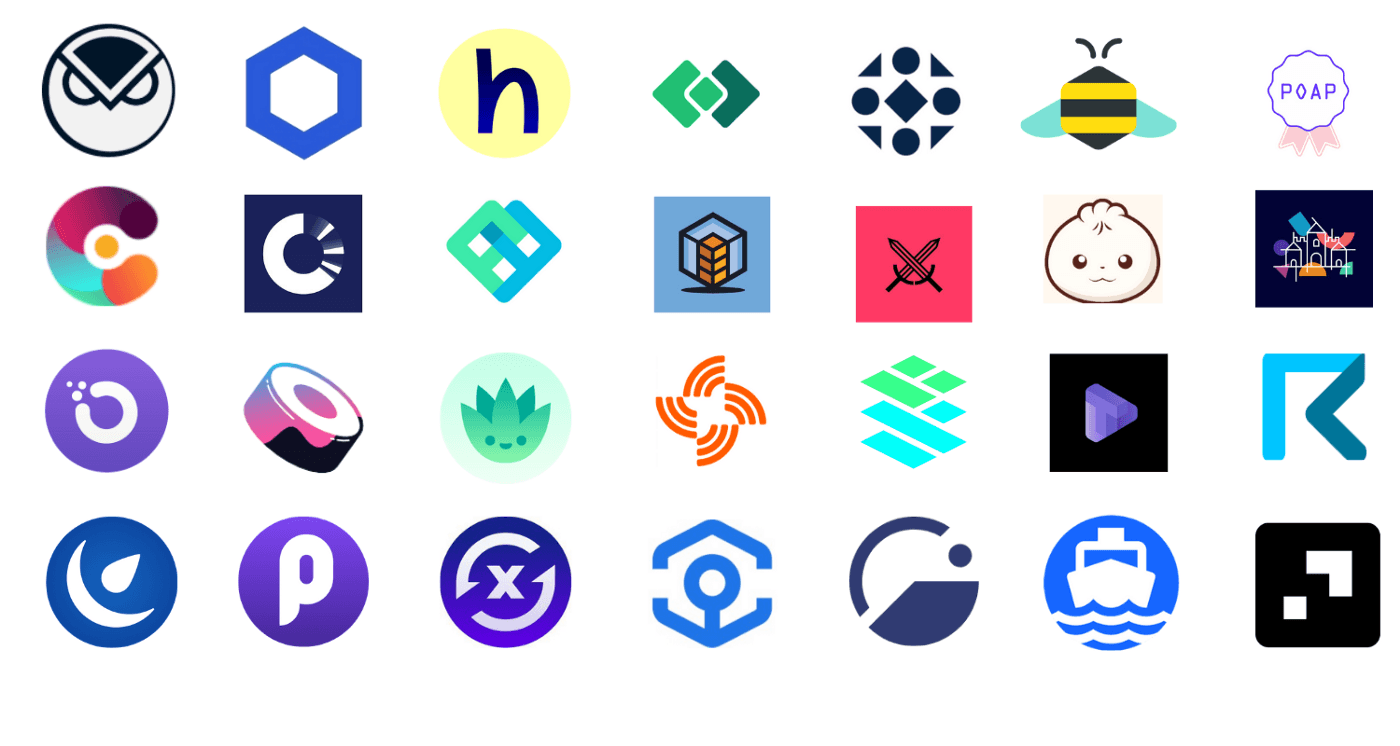LI.FI has announced a $29M Series A extension, led by Multicoin and CoinFund. Read Here.

Gnosis Chain — A Deep Dive
Exploring the Gnosis Chain x LI.FI Partnership
LI.FI is thrilled to support Gnosis Chain in our quest to build out the smoothest user experience in the multi-chain ecosystem. We’re always looking to expand our integrations and to support chains we believe are essential to the cross-chain economy.
What is Gnosis Chain? How does Gnosis Chain work behind the scenes? Why is LI.FI excited to support Gnosis Chain? Read on to find out!
What is Gnosis Chain?
Gnosis Chain is an EVM-compatible scaling solution designed for low-cost, high-speed transactions. Gnosis Chain is technically a new chain. Late in 2021, Gnosis merged with xDAI Chain. Previously, Gnosis was an Ethereum project spun out of ConsenSys that specialized in prediction markets, decentralized exchanges, and wallet solutions, and xDAI Chain was a standalone network built for fast and inexpensive transactions.

Source: xdaichain.com
Gnosis Chain runs on a dual-token framework. xDAI, which is a wrapped version of MakerDAO’s algorithmic stablecoin DAI, is the payment coin of the network. By using a stablecoin for payments and calculating gas in xDAI (a stablecoin), Gnosis Chain can keep fees extremely low. Its other token, STAKE, is designed to govern Gnosis Chain by allowing validators and delegators to secure the chain. In the short term, STAKE will be replaced by GNO (the STAKE — GNO swap is ongoing).
Gnosis Chain is currently secured by the POSDAO consensus, but this will be deprecated in the coming months as the Gnosis Chain incorporates a consensus-layer beacon chain. The Gnosis Beacon Chain mirrors the Ethereum Beacon Chain (with some important optimizations including faster blocks and epoch times). Close to 60,000 validators are already participating as the chain closes in on the merge between the Gnosis Chain EVM and the Gnosis Beacon Chain.
For further reading on Gnosis Beacon Chain, you can check out the…
Gnosis Chain Features
Gnosis Chain boasts the following features:
Lightning-fast tx — with a block time of ~5 seconds, Gnosis allows users to easily make everyday payments (5 seconds is roughly the same amount of time a chip reader takes to read a Visa credit card).
Native stablecoin — xDAI is a stablecoin, which is easier to use for payments than say, Bitcoin, because the price won’t change by the second.
Fee system — gas fees cost .01 xDAI per 500 transactions on Gnosis Chain, and fee costs are paid in xDAI, a stablecoin.
Ethereum compatibility + interoperability — Gnosis is EVM compatible, making it easy for developers to fork ETH-based dApps without expending too much effort.
Scalability — horizontal (connecting additional chains via bridges) and vertical (optimizing validator hardware) scaling is possible as required.
Randomness — true randomness is possible on Gnosis Chain thanks to Gnosis validators, which can be used by smart contracts deployed to Gnosis Chain.
The History of xDAI Chain
The idea for xDAI came from Igor Barinov, a seasoned Ethereum developer who has been in the space since 2015. Igor wanted to create an Ethereum-based sidechain where an ERC-20 stablecoin would become the native token of the said sidechain. DAI was chosen due to its decentralized nature (its backing is made up of multiple tokens, rather than relying on fiat and centralized intermediaries like USDT or USDC).

source: xdaichain.comx
DAI Chain went live in October 2018 using a one-token transactional model in a push to create a network perfect for peer-to-peer transactions with controlled gas prices. In its early days, xDAI functioned as a proof of autonomy chain (a semi-centralized consensus mechanism built on top of proof-of-authority). However, unlike proof-of-authority, which relies on a “root key” to manage a validator set for the entirety of a chain’s history, proof-of-autonomy delegates the “root key” to a DAO of validators after a certain number of invites.
From there, xDAI transitioned to a consensus algorithm called POSDAO. Here, xDAI introduced a dual-token methodology, wherein xDAI is used for transactions, while STAKE is used to validate the chain. The POSDAO construction allowed xDAI to immediately become more scalable than Ethereum 1.0, in addition to unlocking POS native functionality like delegated staking, high transaction speeds, and low transaction costs. In a POSDAO network, users stake tokens in an effort to become validators on the network. Delegators can stake tokens to these candidates, providing a “vote” for a particular candidate by contributing to their pool. Validator sets are selected based on the size of their pool and a randomness beacon. The larger the pool size, the greater the probability of selection, with only 19 validators allowed on the network at a given time. Much like other POS-enabled networks, once selected, validators are responsible for signing blocks and securing the network for a predetermined amount of time (when that ends, a new validator set is elected).
Next, the POSDAO consensus algorithm will be phased out in favor of a consensus layer beacon-chain on par with Ethereum’s via Gnosis Beacon Chain. Once the merge happens for the respective chains, researchers will explore implementing a trustless bridge that relies on conensus-layer validators.
xDAI Chain 👉 Gnosis Chain

Source: Gnosis’s blog post announcing the merge
In 2021, xDAI Chain experienced a rebrand after Gnosis initiated and completed an xDAI-Gnosis merger. Gnosis is an early blockchain project spun out of ConsenSys that specializes in three products:
Prediction market tooling
: Gnosis’s conditional token framework has been built upon by prediction markets like Polymarket and Omen
Decentralized exchanges: Gnosis Protocol has facilitated trades for 50,000+ DeFi users
Smart contract wallets and multi-sig solutions: Gnosis Safe secures more than $1 billion in assets
The rebranding of xDAI Chain to Gnosis Chain was implemented to transform the chain from a “staging ground” chain to a “destination” and “permanent home” for developers and crypto users. In essence, xDAI Chain had flourished as a breeding ground for innovation in the past, with builders spinning out products like POAP, Dark Forest, and Circles, which are key pieces of infrastructure in the crypto economy. However, it never picked up mainstream attention, despite boasting impressive development.
With the rebrand, Gnosis is attempting to make xDAI Chain a “comprehensive & complete chain” by changing the name to the “Gnosis Chain.” A swap is underway to transfer the STAKE token to the GNO token. This swap began in December, with Gnosis facilitating an exchange rate of .03262 GNO/STAKE swaps for all users. Overall, Gnosis plans to use 19% of the current supply of GNO to complete this swap. Additionally, GnosisDAO has reserved 400K GNO to develop Gnosis Chain and incentivize usage.
POSDAO will continue being used as the consensus algorithm on Gnosis Chain. However, Gnosis Chain will be integrated as a shard into the Gnosis Beacon Chain in the future.
TL;DR → In 2021, xDAI Chain transitioned to Gnosis Chain, thereby combining Gnosis’s expertise in building DEXs, prediction market tooling, and wallet solutions with xDAI Chains’ experience running a robust, developer-friendly, and cheap EVM compatible chain.
LI.FI Now Supports Swaps To Gnosis Chain
Creating a superb cross-chain user experience is the foundational premise of LI.FI. Our product is simple: we are a cross-chain bridge and DEX aggregation facilitating any-2-any swaps. We have built a slew of cross-chain tools via an API, widget, and SDK that enables dApps to allow users to buy, swap, or deposit any asset from any chain within their platform. All bridges and DEXs are aggregated into a one-click user interface.
Supporting Gnosis Chain is a no-brainer for LI.FI. We want users to fully leverage the cross-chain ecosystem, of which Gnosis Chain is an integral part. With 28 dApps and $248 billion in total value locked, Gnosis Chain itself supports a vibrant and diverse selection of crypto tooling.

As an EVM-compatible chain, Gnosis Chain is home to some of the biggest names in crypto like SushiSwap, Curve, and Perpetual Protocol. Gnosis Chain also hosts a few homegrown applications that have made a large impact on the crypto industry, like POAP (an NFT mechanism designed to reward users for participating in DAOs) and Dark Forest (an MMO space conquest game that was one of the first popular P2E games).
Why the LI.FI and Gnosis Chain relationship will be symbiotic.
Gnosis Chain exists to facilitate high frequency and cost-efficient EVM-compatible transactions. Activity on Gnosis Chain is high, as the chain facilitated between 100,000–300,000 daily transactions for the month of February. As mentioned above, Gnosis Chain is home to a wide variety of crypto tooling that includes DEXs, NFT infrastructure, DAOs, gaming, and more. However, to fully unlock the potential of Gnosis Chain assets and protocols, users must be able to directly leverage tokens from other chains.
This is where LI.FI comes in, as LI.FI allows users to swap assets from, for example, Ethereum, directly to Gnosis Chain. From there, users will be able to engage and utilize the now Gnosis-native asset in whatever way they choose. It also works in the other direction, where users can send out Gnosis-native assets to other chains, for example, Fantom, where they can use the now Fantom-native asset in whatever way they choose. And, of course, since LI.FI is a bridge and DEX aggregator rather than a single bridging mechanism, Gnosis Chain users will have a plethora of options to choose from when bridging (rather than relying on a single point of failure bridge).
TL;DR → Gnosis Chain benefits from LI.FI because users can now bridge assets to and from Gnosis via a single widget, which should increase the number of assets and traffic available on Gnosis Chain. LI.FI benefits from supporting Gnosis Chain because it is a vibrant chain where users will want to bridge assets to and from, which will hopefully push more traffic through LI.FI.
Conclusion
LI.FI is thrilled to bring Gnosis Chain into our cross-chain family. We strongly believe that Gnosis Chain’s ability to facilitate low-cost stablecoin payments makes it an integral part of the crypto metaverse. In addition to xDAI payments, the chain’s development is impressive and should lead to Gnosis Chain being considered a destination chain via dApps like POAP and Circles.
The future is multi-chain and LI.FI is striving to become THE solution for cross-chain bridging. To do so, we must partner and maintain good relationships with the strongest blockchains, bridges, DEXs, and dApps… so, obviously, we’re grateful to have Gnosis Chain in the LI.FI family!
We’ve partnered up with the brightest minds and aim to build the best abstraction and aggregation solution available on the market. If you’re a blockchain network, bridge builder, wallet, or dApp developer, come talk to us and let’s work together!
To learn more about Gnosis Chain, check out:
FAQ: Gnosis Chain — A Deep Dive
Get Started With LI.FI Today
Enjoyed reading our research? To learn more about us:
- Head to our link portal at link3.to
- Read our SDK ‘quick start’ at docs.li.fi
- Subscribe to our newsletter on Substack
- Follow our Telegram Newsletter
- Follow us on X & LinkedIn
Disclaimer: This article is only meant for informational purposes. The projects mentioned in the article are our partners, but we encourage you to do your due diligence before using or buying tokens of any protocol mentioned. This is not financial advice.